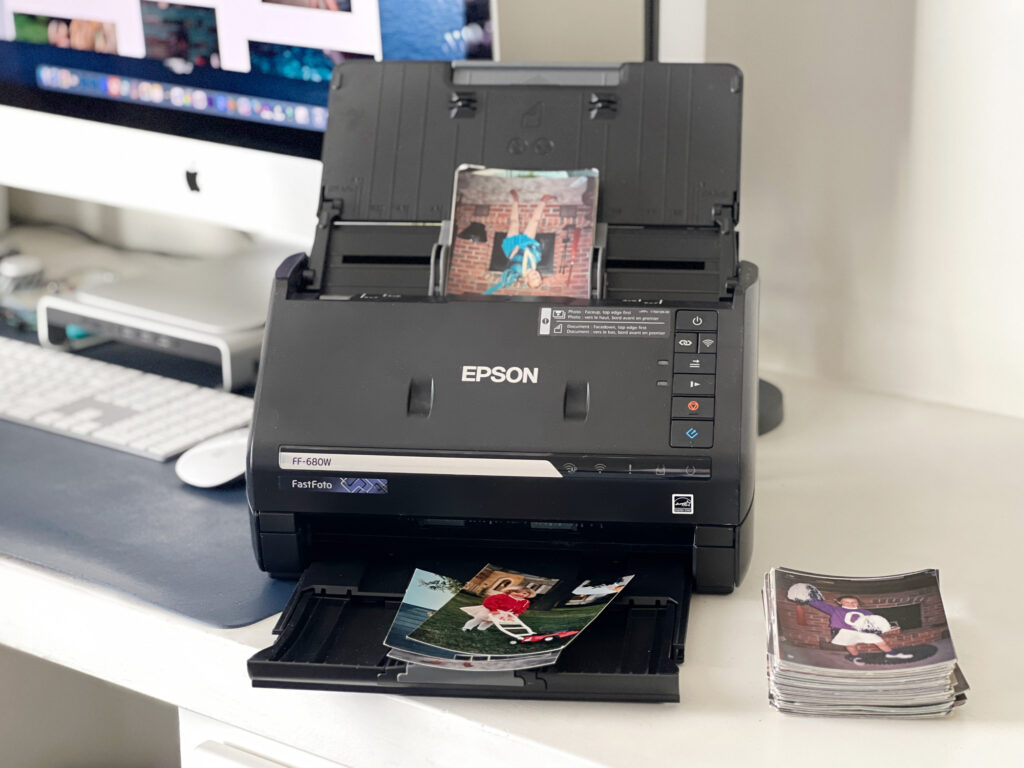I digitize photos for a living so I’m often asked “what’s the best photo scanner if I want to scan photos myself?” Of course, I have thoughts.
My first tip: don’t use an all-in-one printer to scan your photos.
The scanner that is built into a printer is meant for documents, not photos. Will it scan photos? Sure, it’ll scan anything you lay on the glass. But the color quality, in my experience, is not great. Instead, I recommend investing in a photo scanner for your project.
My second tip: don’t use a flatbed if you have a large volume of photos to scan.
This one is purely about managing your time wisely, not scan quality. A flatbed photo scanner will give excellent quality scans. But you have to manually place each photo on the glass, wait for the scan to complete, then move onto the next item. This is great for a small number of photos, old photos, or fragile items. Or if you don’t mind spending a lot of time on this project. But when you have a really large quantity of photos to scan, I recommend investing in a high-speed photo scanner.
My third tip: let the scanner do the organizing work.
The photo scanner I recommend comes with easy-to-use software that will automatically date, name, and save your scanned files into descriptively named folders. For example: when you describe a batch of photos as “1980 Hawaii,” it will create a folder called 1980 Hawaii. Then it will place each scan inside that folder, naming it 1980 Hawaii 001, 1980 Hawaii 002, and so on. It will also set the date of these files as 1980 so when you later bring them into your preferred cloud service or photo management program, they’ll display in the correct year instead of the date you did the scanning project. All of this un-seen work makes a big difference in the long-run.
For those three reasons, I think the best photo scanner is….. drumroll….

The Best Photo Scanner: Epson FastFoto 680
The Epson FastFoto looks more like a printer or a fax machine versus a flatbed scanner. You can set a stack of several photos onto the tray, assign a batch name in the Epson software, and start the scanner. Each file is pulled through the scanner individually and cropped automatically. So you can even set a stack of assorted sizes and shapes on the scanner! Such a time saver!
The Epson FastFoto software is really easy to use too! In addition to the organizational features I mentioned above, it has automatic color enhancement options. I don’t personally use them 100% of the time, but they can really help with older photos that are faded or discolored.
Did I mention the Epson FastFoto works great on documents as well? You can scan multi-page, multi-sided documents as pdf so they all become one file.
A Few Money-Saving Tips
The Epson FastFoto is a big investment, but I have a few tips for saving money on your purchase.
- Wait for a sale. The Epson FastFoto is frequently $500-529 on Amazon so if you see it being sold for more than that, consider waiting until it comes back within that range.
- Check Epson Refurbished stock. This is constantly changing, but periodically an Epson FastFoto will be available there for about $400 with a great warranty.
- Share the cost with friends of family. So many people have physical photos in their home that need to be digitized. If you’ll be tackling a big scanning project for your family, consider asking your siblings or parents to share the cost of the scanner with you. They’re going to benefit from the end product, after all! Or maybe friends or neighbors in your area would like to use the scanner when you’re done with your project and will split the investment.
- Re-sell the scanner when you’re finished. It’ll vary by area, but you may get half your investment back when you re-sell. Plus, the ‘deadline’ of selling the scanner will help you get the project done!
One final tip: Don’t let the scanner sit in the box collecting dust.
I hear this all the time. “I bought the scanner you recommended, but I’m afraid to open it!” Listen to me: you need to open the box. All that’s involved in “getting started” is installing software (maybe 3-4 mins) and plugging in the power (<1 minute). That’s it.
Find a handful of photos or documents around your home to quickly scan so you can ‘rip the bandaid off’ and get over any fear about using this scanner. It’s just silly because scanning photos is fun! I can’t wait for you to uncover many long-forgotten memories as you do this work!
Need help with your photo scanning project? My Organizing Old Photos course covers my workflow for sorting physical photos, my recommend scanning settings, and more!
Would you rather hand your scanning project over to a professional? Learn more about my photo scanning services.
Note: This blog post contains affiliate links which means I will make a small commission off your purchase, at no cost to you. Thank you for supporting my small business!